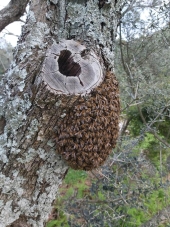

Julie E. Johnson wrote:I have finally acquired two very small paw paw seedlings and I am wondering if you might have any tips on how to plant them and when to plant them? I live in East TN. Which is zone 7 . Any info would be appreciated.
Eino Kenttä wrote:If they grow well, lingonberries would make a neat groundcover. Around here (northern Scandinavia) lingonberries, bilberries and a couple other acid-soil berries are so common in the wild that no one attempts to grow them. Where lingonberries do grow, they tend to form quite dense populations. Since they are evergreen, if you got them well established they might shade out the buttercups' new growth in spring? Don't know anything, just guessing.
Also, aren't buttercups a high-nitrogen indicator?


B Permie wrote:
Greg B Smith wrote: The pics below are composted wood chips that were put down 2 plus years ago. Also pictured is the compacted clay. Zone 8 Central Mississippi...
I know it's a long shot but is there an update to this situation? I am in almost the exact situation, north central MS, at least 4 ft of clay, and I've been working on a solid layer of organic on top. The area had zero top soil when I moved here. I've now got about 7 inches of leaf and crass clippings that have been breaking down for a year or two, and it seems like this year things are growing well enough in it..
There is still a very obvious divide between clay and organic, and I don't know if it is worth fighting or not. I feel like "punching through" the clay would be an excercise in futility due to the depth, and I wonder if my best bet is to just bring in some soil to mix in and just garden on top of the clay? Or just keep waiting as the crawdads and fireants keep bringing up mounds of clay into the compost.





David Baillie wrote:So much of this is local. if its on clay with no gravel layer yeah the tube wont do much. hunt cracks, ventilate from low down, maybe even redirect your cold air return a little higher. Good luck. Short of being there that about all I got.
Cheers, David


David Baillie wrote:
Nice! so you are most of the way there. Did they seal along the perimeter and cracks? did they do the sump well if you have one? I have worked in dozens of fixer uppers but have only owned two houses both of which i built. I don't think I could do it any other way (a wee bit pickey I'm told)Og Duzle wrote:
David Baillie wrote:So, the vapour barrier gets installed on the slab itself all the way to the edges of the walls and the edges are taped to the walls themselves. Is your basement finished or just plain poured or block walls? Radon tends to migrate in through the edges of the slab where it touches the cement walls, cracks in the foundation and any penetrations especially sump pump wells. Its a heavy gas so wants to stay low until the hvac pulls it up. Most mitigation involves sealing all cracks and penetrations, creating a sealed layer using a membrane then applying a small amount of negative pressure to it. Often times sealing an existing sump pump well with a tight cover and adding a low power suction ventilator will reduce amounts below detection levels. Here is an article on a pro job. You can diy most of this and get good results. Those radon fans are awesome though much better then a $40 duct fan that I've used before. https://www.proremodeler.com/how-retrofit-radon-mitigation-system
I understand. Thanks! The basement is unfinished and it was leaking water when we bought the house. I used hydraulic cement along the edges of wall/floor contact to seal the line of contact alongside the whole wall perimeter and I painted all the walls with one of those 15psi resistant paints three times. Now I do not have water intrusion anymore. When we were buying the house I insisted on a radon test (locals laughed, this is a rural area) and it came back high (I shudder to think what the rest of the people in the area are ignoring). I had a radon remediation "system" installed, which is basically a pipe that is drilled through the slab into the ground with a fan pulling the radon out (supposedly). I find that it is not very effective.